- Home
- Valuable US Coins
Top 10 Most Valuable US Coins
The top 10 most valuable US coins of all time have a combined value of around $83,000,000 as of 2024.
Some of these old coins are very rare with mintages less than 10.
The most valuable and rarest of these collector's items is the 1933 Double Eagle which sold for $18,872,250 at Sotheby's on June 8th, 2021.
All of these highly valuable coins were sold for record auction prices at either Stack's Bowers Galleries or Heritage Auctions with the exception of the 1933 Double Eagle.
I haven't included any privately sold coins in this list because I was unable to find accurate records of their exact sale values and to whom they were sold.
Although according to Wikipedia there were private sales of a 1787 Brasher Doubloon (EB on Breast) for $7,395,000 in December 2011 and a 1913 Liberty Head Nickel for $5,000,000 in April 2007.
I also didn't include the world's largest gold coin as I didn't think a $1 Million coin the size of a car wheel counted as pocket change.
Another interesting fact is that 6 of the top 10 list were designed by Robert Scot, an American engraver, who created some of the most popular early coinage designs such as the Flowing Hair dollar, Liberty Cap half cent and Draped Bust.
All of these rare coins were also minted in Philadelphia, except the Brasher Doubloon's which were privately minted.
None of the coins produced in the San Francisco mint or the Denver mint made the cut.
Sadly there weren't any Morgan silver dollars, Buffalo nickels or rare error coins such as the Lincoln Head copper penny from World War II that made the list.
Even some of the most valuable coins in America, such as the 1913 Liberty Head nickel and 1792 Birch cent, were just outside the top 10.
Most Valuable US Coins List 2024
- 1787 EB on Wing DBLN MS63 ($4,582,500)
- 1794 Flowing Hair Silver Dollar MS66+ ($4,993,750)
- 1804 $10 Plain 4 Eagle PR65+DCAM ($5,280,000)
- 1794 Flowing Hair Silver Dollar MS66+ ($6,600,000)
- 1861 $20 Paquet Double Eagle MS67 ($7,200,000)
- 1804 Draped Bust Silver Dollar PR68 ($7,680,000)
- 1822 Capped Head Left Half Eagle AU50 ($8,400,000)
- 1787 EB on Wing DBLN MS65 CAC ($9,360,000)
- 1794 Flowing Hair Silver Dollar SP66 CAC ($10,016,875)
- 1933 Double Eagle MS65 CAC ($18,872,250)
#10) 1787 New York-Style Brasher Doubloon
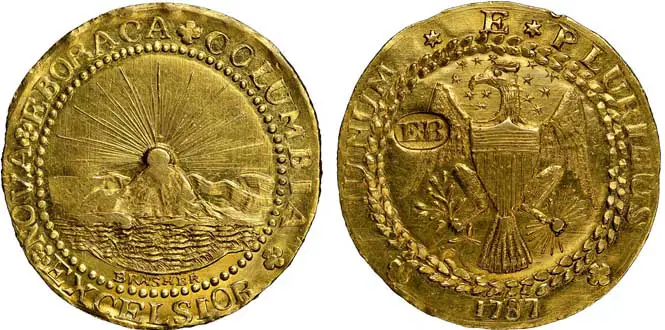
Image Source: Courtesy of Heritage Auctions
- Designer: Ephraim Brasher
- Mint: Privately Minted
- Metal Composition: 89.3% Gold - 6.4% Silver - 3% Other
- Diameter: 29.8mm
- Weight: 26.4 grams
- Mintage: 7
- Highest Sale Price: $4,582,500 (MS63)
#9) 1794 Flowing Hair Silver Dollar
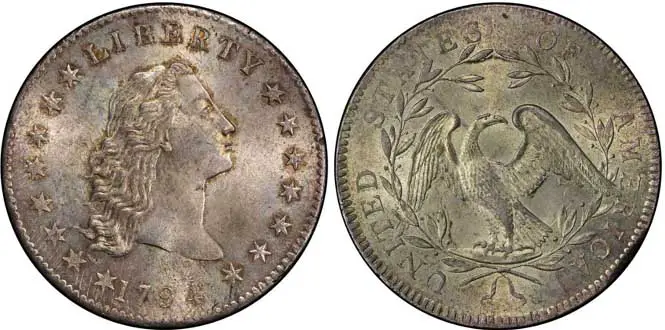
Image Source: Courtesy of Stack's Bowers Galleries
- Designer: Robert Scot
- Metal Composition: 90% Silver - 10% Copper
- Diameter: 40mm
- Weight: 27 grams
- Minted: 1758
- Highest Sale Price: $4,993,750 (MS66+)
#8) 1804 $10 Plain 4 Eagle
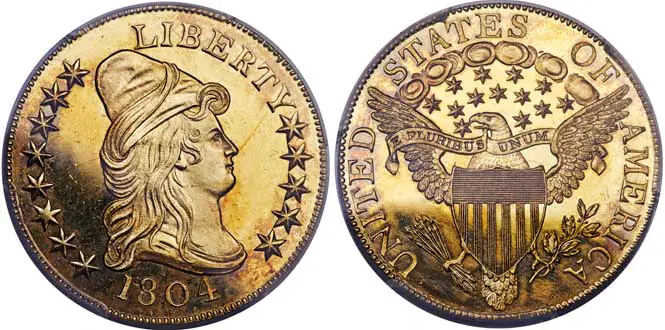
Image Source: Courtesy of Heritage Auctions
- Designer: Robert Scot
- Metal Composition: 91.7% Gold, 8.3% Copper
- Diameter: 33mm
- Weight: 17.5 grams
- Mintage: 4
- Highest Sale Price: $5,280,000 (PR65+DCAM)
The 1804 Plain 4 proof Eagle stands as an exceedingly rare and highly valuable chapter in the annals of American coinage history.
Much like their renowned counterparts, the 1804 Plain 4 Eagles were minted as part of diplomatic presentation proof sets, intended as prestigious gifts for foreign dignitaries during the mid-1830s.
This elite class of coins consists of just four pieces in total, and today, numismatists are aware of only three of them.
Remarkably, one of these three surviving specimens is housed within the illustrious Harry Bass Core Collection, proudly on display at the ANA headquarters, and forever withdrawn from the market.
This present coin is the finest-known specimen of this coveted early gold rarity, hailing from the extraordinary Bob R. Simpson Collection.
This exceptional gold coin, graded as a PR65+ Deep Cameo, stands as the most exquisite among the trio of these early gold rarities that are known to exist.
The design details showcase an astonishing level of precision, with the exception of a peculiar softness observed on obverse star 3.
The remaining stars exhibit full centers, hinting at a possible partial obstruction during the striking process that affected star 3.
Intriguingly, the King of Siam's specimen also presents a similar flat center on star 3, while the Harry Bass example boasts sharp detailing in this particular region.
An elusive thin die crack extends from Liberty's hair down to the base of the upright of the R in LIBERTY.
This intriguing feature is shared with the King of Siam specimen but conspicuously absent on the Bass coin.
These distinct striking characteristics suggest that the Simpson coin and the King of Siam specimen were minted concurrently, under the same circumstances.
In contrast, the Bass coin appears to have been struck later, after the obstruction in star 3 had been cleared, and a gentle polishing had removed the die crack.
Given that both the King of Siam and Sultan of Muscat proof sets were minted in November of 1834, it is reasonable to deduce that the Simpson coin is from the Muscat set.
Consequently, the Bass coin must belong to one of the undelivered proof sets struck in April of 1835.
#7) 1794 Flowing Hair Silver Dollar
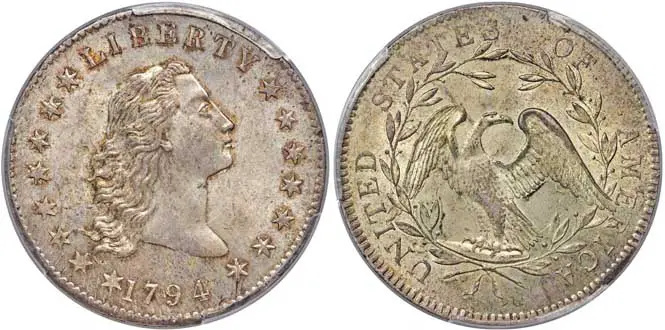
Image Source: Courtesy of Heritage Auctions
- Designer: Robert Scot
- Metal Composition: 90% Silver - 10% Copper
- Diameter: 40mm
- Weight: 27 grams
- Minted: 1758
- Highest Sale Price: $6,600,000 (MS66+)
The narrative surrounding the 1794 silver dollars, with a limited mintage of 1,758 coins, is a captivating tale filled with intrigue and mystery, echoing through time.
Recent years have unraveled some of its enigmatic layers, shedding light on the lineage of the renowned Lord St. Oswald coins.
Among this distinguished collection, the 1794 dollar stands out as an extraordinary specimen, a testament to its remarkable originality and resplendent luster.
Its very existence is a testament to both survival against the odds and the story of a cherished national treasure, now returned to its rightful home.
Although it wasn't the very first silver dollar minted, nor among the first few, it bears the telltale signs of die clashing, characteristic of a middle die state (known as Bowers Die State II).
While the planchet didn't receive special treatment, it boasts fewer adjustment marks than the vast majority of 1794 dollars.
Out of the 135 to 150 1794 silver dollars that remain today, this particular coin appears to have benefited from luck both in its striking and planchet quality, likely set aside with care for a specific purpose.
Logically, some coins were preserved as samples, supported by the presence of a handful of 1794 silver dollars in Mint State, along with one Specimen strike.
It's conceivable that David Rittenhouse or other prominent Mint officials laid eyes on this very coin at some point shortly after its minting, hand-picking it for a special role.
A compelling argument arises when considering this 1794 silver dollar as the pinnacle of "regular circulation strike" specimens.
Delving deeper into its intricacies, each strand of Liberty's flowing hair is meticulously defined, from the delicately rendered forehead to the graceful bottom curl.
On the reverse, a striking level of detail graces this 1794 dollar, with only a negligible hint of weakness affecting the letters "AT" in "STATES."
Unlike many 1794 dollars bearing extensive adjustment marks, this coin exhibits only a few, mostly confined to the lower-left obverse margin.
The date and stars in this region remain crisply defined, while the central strike achieves needle-sharp precision. The reverse rim displays a minor flat spot near "RIC" in "AMERICA."
#6) 1861 $20 Paquet Double Eagle
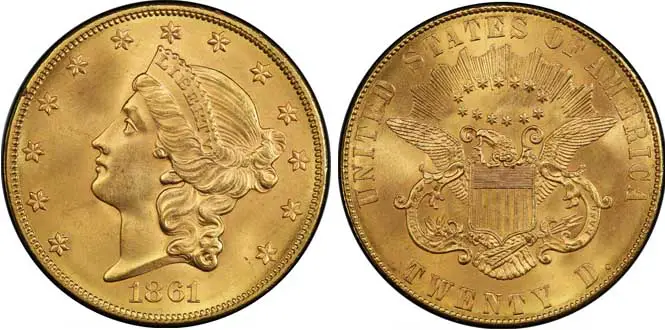
Image Source: Courtesy of Heritage Auctions
- Designer: James B Longacre
- Metal Composition: 90% Gold - 10% Copper
- Diameter: 34mm
- Weight: 33.44 grams
- Mintage: 2
- Highest Sale Price: $7,200,000 (MS67)
This particular coin, a MS67 CAC, stands as a shining exemplar within the realm of numismatic treasures, outshining its peer by a substantial six-grade margin.
It also claims the title of the finest specimen among Paquet design coins. It was bought for $7,200,000 in August 2021.
This awe-inspiring Superb Gem boasts an impeccable level of detail across its entire surface.
Every intricacy of the design elements, from the stars to Liberty's delicate hair strands and the eagle's feathers, stands out with unparalleled precision.
Notably, the base of the first "1" in the date bears evidence of meticulous repunching, while tiny die lumps subtly grace the corners of stars 9 and 10.
The coin's virtually flawless orange-gold surfaces emanate a robust, satin-like mint luster from every angle, revealing numerous traces of artful die polishing in the fields.
A minuscule amber alloy spot appears along the obverse rim, adjacent to star 4, adding to the coin's character.
The CAC sticker proudly affirms the exceptional quality and visual appeal of this piece.
While this coin has had the privilege of gracing some of history's most esteemed numismatic collections, it has made only sporadic appearances in recent years.
Remarkably, it has journeyed to auction a mere two times since the 19th century, with the last occurrence being 33 years ago in the renowned Norweb Collection.
#5) 1804 Draped Bust Silver Dollar
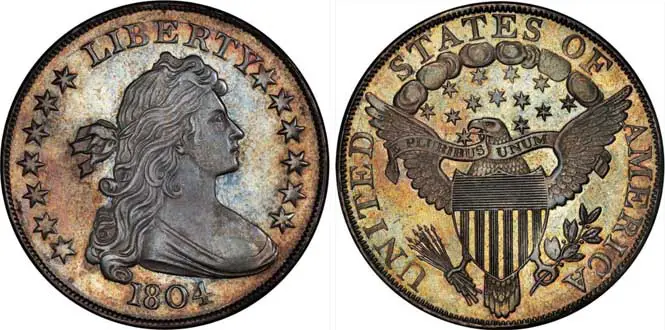
Image Source: Courtesy of Stack's Bowers Galleries
- Designer: Robert Scot
- Metal Composition: 89% Silver - 11% Copper
- Diameter: 39.5mm
- Weight: 26.96 grams
- Minted: 8
- Highest Sale Price: $7,680,000 (PR68)
Silver coins are very popular in the top 10 list of United States coins in circulation.
This 1804 mint condition proof from the Philadelphia facility is a great asset for a coin collector to own.
It went for $7,680,000 on August 17th, 2021, at Stack's Bowers Galleries.
Silver and Gold are the two most popular precious metals in the composition of collectible coins.
It hard to think about how a small metal coin originally worth just one dollar can sell for millions of times its face value.
#4) 1822 Capped Head Left Half Eagle
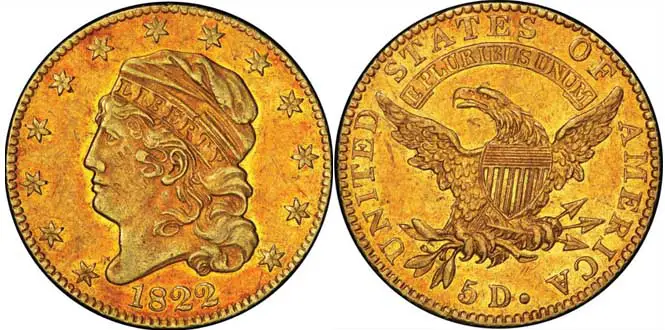
Image Source: Courtesy of Stack's Bowers Galleries
- Designer: Robert Scot & John Reich
- Metal Composition: 91.7% Gold - 8.3% Copper
- Diameter: 25mm
- Weight: 8.75 grams
- Mintage: 17,796
- Highest Sale Price: $8,400,000 (AU50)
This 1822 Half Eagle is a BD-1 variety and the coin sold for $8,400,000 on March 25th, 2021.
With a Rarity-8 rating, meaning only one exists, it is also one of the most scarce and expensive coins in America.
It is graded AU-50 by PCGS, indicating that it is in About Uncirculated condition. This means that the coin has seen some wear, but still retains a significant amount of its original luster and detail.
#3) 1787 New York-Style Brasher Doubloon
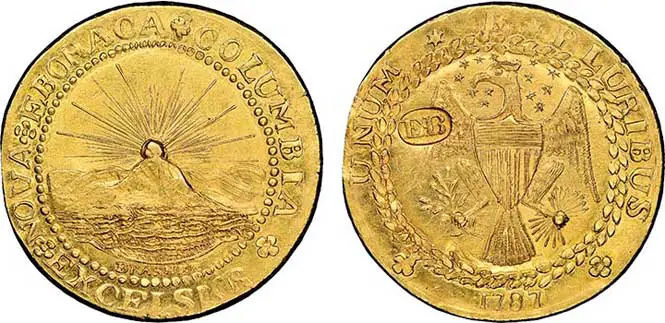
Image Source: Courtesy of Heritage Auctions
- Designer: Ephraim Brasher
- Mint: Privately Minted
- Metal Composition: 89.3% Gold - 6.4% Silver - 3% Other
- Diameter: 29.8mm
- Weight: 26.41 grams
- Minted: 7
- Highest Sale Price: $9,360,000 (MS65)
The 1787 New York-Style Brasher Doubloon with the "EB" hallmark on the wing was privately minted by Ephraim Brasher.
He was a famous and highly skilled goldsmith from New York city with an exceptional eye for detail.
This doubloon is thought to be the one of first gold coins produced in America.
The "EB" hallmark, which was stamped on the wing of the eagle on the reverse side of the coin, is believed to have been added by Brasher himself as a form of authentication.
This valuable coin W-5840 is known as the Stickney Ellsworth Garrett Partrick example, and with a grade of MS65 is the finest known example of the seven rarest coins ever produced in the US.
#2) 1794 Flowing Hair Silver Dollar
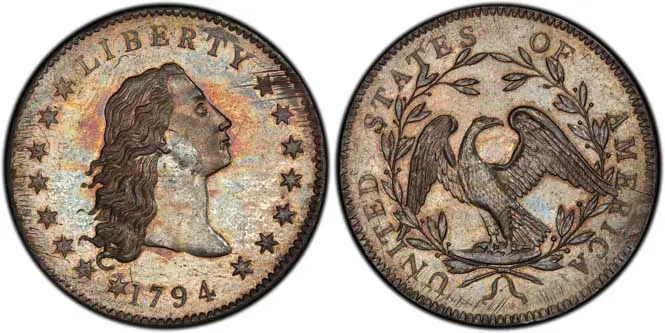
Image Source: Courtesy of Stack's Bowers Galleries
- Designer: Robert Scot
- Metal Composition: 90% Silver - 10% Copper
- Diameter: 40mm
- Weight: 27 grams
- Mintage: 135
- Highest Sale Price: $10,016,875 (SP66)
This is an extremely rare coin that changed hands for $10,016,875 in January 2013. It's most likely one-of-a-kind and highly sought after by collectors.
This coin, which was produced in the US in 1794, was the first silver dollar ever produced by the United States Mint.
One of the most interesting aspects of the 1794 Flowing Hair is its "silver plug."
The silver plug was added to the coin by an authorized goldsmith in order to bring its weight up to the required standard.
This strike known as Specimen-66 is one of the finest known examples of 1794 Flowing Hair dollar.
This coin, which is graded SP66 by the Professional Coin Grading Service (PCGS), has surfaces which are almost proof like and it has minimum marks from handling.
#1) 1933 Double Eagle
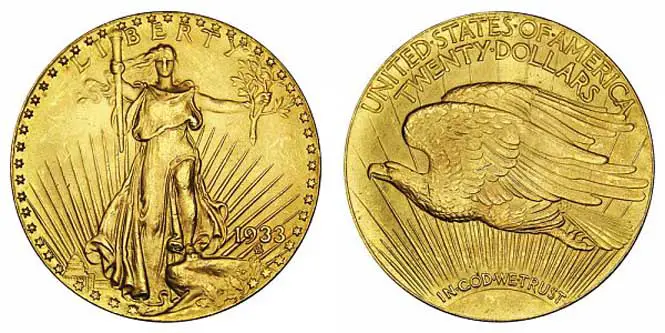
Image Source: USA Coinbook
- Designer: Augustus Saint Gaudens
- Metal Composition: 90% Gold - 10% Copper
- Diameter: 34mm
- Weight: 33.40 grams
- Minted: 445,500
- Highest Sale Price: $18,872,250 (MS65)
This 1933 Double Eagle $20 gold coin (no mint mark) designed by the engraver Augustus Saint Gaudens and known as the Farouk Specimen is the most valuable US coin ever sold at auction.
It was sold for $18,872,250 at Sotheby's auction on June 8th, 2021 earning it the title of most expensive coin breaking all previous world records.
The seller was Stuart Weitzman who bought it anonymously nearly twenty years earlier in 2002 for $7,590,020.
It was originally owned by King Farouk of Egypt who bought it in 1944, although it should never been for sale due to Executive Order 6102 signed by President Franklin D. Roosevelt.
After King Farouk was deposed in 1952 in a coup d'etat, all of his possessions were sold off at auction including this expensive coin.
During this time the gold coin disappeared for many years and didn't reappear until 1996 under controversy as it was wanted by the US government.
After the gold recall, all 1933 Double Eagles were supposed to have been destroyed and never entered into circulation.
Although some were stolen from the Mint prior to this and the US government has been hunting for them ever since.
The Farouk double eagle was legally obtained by the King through an error of the government, so it is the only one that is legal to own by a private collector.
After the United States government confiscated the $20 gold coin from Stephen Fenton in 1996, due to the obscure nature in which he acquired the exceedingly rare gold bullion, it was agreed in a civil case that it would be legally sold at auction to the highest bidder.
The sale happened on July 20th, 2002, at Stack's Bowers auction and the 1933 $20 Double Eagle was sold to Stuart Weitzman for $7,590,020.
The final proceeds were split between the US Treasury and Stephen Fenton almost half and half.
